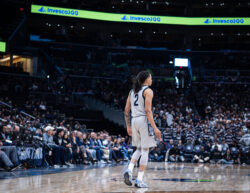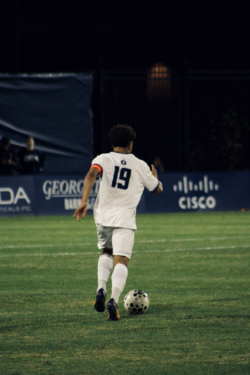If you’re looking for senior leadership on this year’s Georgetown roster, you’re out of luck. No member of the class of 2010 will be on the court with the Hoyas at the Verizon Center this season. That’s not to say they can’t be found—just look towards Bloomington, Gainesville, or Detroit. That’s where you’ll find Jeremiah Rivers, Vernon Macklin, and DaJuan Summers—all freshmen on the 2007 Final Four team—playing this year.
Nowadays, the college basketball star that stays at a single school for all four years has become rarer than a clean urine sample. The prospects of money and fame—not to mention strategic factors like a weak draft class or avoiding injury—push many to declare for the draft after the required one year of college. Middling players will transfer after a short time at a premier program, in order to find greater exposure on a mid-major team. Perversely, a good season can harm a team’s prospects for the next year, since its best players will receive more attention from the professional establishment and more pressure to turn pro.
Georgetown has traditionally benefited from one of the highest graduation rates in college basketball. In John Thompson Jr.’s twenty-seven years as head coach, he lost only two players to the draft—one of them the 1996 number one overall pick, Allen Iverson. According to a study from the University of Central Florida, Georgetown had the thirteenth best six-year graduation rate among 2008 NCAA tournament teams, with 82 percent of the men’s team graduating between 2001 and 2007. Since the 2007-2008 season however, Georgetown has graduated five players while losing four to other forms of attrition—one to the pros and three to other programs. This is a problem.
The importance of upperclassmen to a basketball program cannot be overstated. Older players are likely to have more productive relationships with their coaches and staff. Upperclassmen have experience in one school’s system, which is especially important for Georgetown’s complicated Princeton offense. During the long haul of the regular season, upperclassmen can keep younger teammates’ attention focused on the game. In tournament play, the more seasoned athletes can be instrumental in controlling the emotions of their newer teammates.
Last season, with only one scholarship senior on the team, the Hoyas won ten of their first eleven games, including a win at No. 2-ranked, and previously undefeated, Connecticut. From that point on, Georgetown went an anemic 6-14, including only two victories in nine games played on the road. This was eerily similar to JTIII-predecessor Craig Esherick’s last season coaching, when, after losing team leader Michael Sweetney to the NBA, a young Hoyas team began on a high note before losing the last nine games of the season and missing the NIT.
Part of the problem is that Thompson is very good at recruiting top players, and top players are more likely to go pro before completing four years. Jeff Green left after his junior year to pursue a career in the NBA, as did Summers after last season. But Summers, who was picked thirty-fifth overall, ended his college career on a mediocre season. Roy Hibbert, who by all accounts would have been a top pick after his junior-year performance in 2007, returned to Georgetown for a fourth year. What explains the difference between the two choices?
JTIII better figure it out soon, or else every season will be a rebuilding year.
Jeff won’t leave you. Contact him at jbakkensen@georgetownvoice.com.





completely right. why hoya blue gives JT III a free pass is beyond me